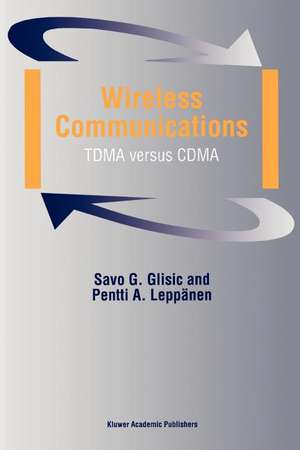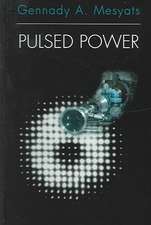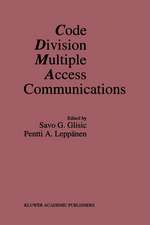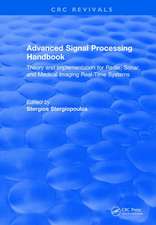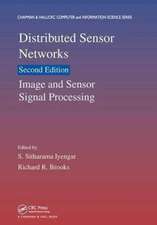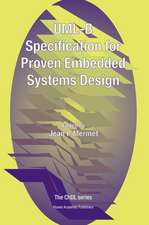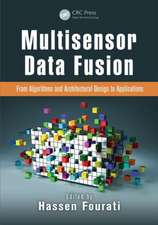Wireless Communications: TDMA versus CDMA
Autor Savo G. Glisic, Pentti A. Leppänenen Limba Engleză Paperback – dec 2010
Wireless Communications: TDMA versus CDMA provides enough information for correct understanding of the arguments in favour of one or other multiple access technique. The final decision about which of the two techniques should be employed will depend not only on technical arguments but also on the amount of new investments needed and compatibility with previous systems and their infrastructures.
Wireless Communications: TDMA versus CDMA comprises a collection of specially written contributions from the most prominent specialists in wireless communications in the world today and presents the major, up to date, issues in this field. The material is grouped into four chapters: Communication theory, covering coding and modulation, Wireless communications, Antenna & Propagation and Advanced Systems & Technology.
The book describes clearly the issues and presents the information in such a way that informed decisions about third generation wireless systems can be taken. It is essential reading for all researchers, engineers and managers working in the field of Wireless Communications.
| Toate formatele și edițiile | Preț | Express |
|---|---|---|
| Paperback (1) | 956.50 lei 43-57 zile | |
| Springer Us – dec 2010 | 956.50 lei 43-57 zile | |
| Hardback (1) | 961.55 lei 43-57 zile | |
| Springer Us – 30 aug 1997 | 961.55 lei 43-57 zile |
Preț: 956.50 lei
Preț vechi: 1166.47 lei
-18% Nou
Puncte Express: 1435
Preț estimativ în valută:
183.05€ • 190.40$ • 151.12£
183.05€ • 190.40$ • 151.12£
Carte tipărită la comandă
Livrare economică 14-28 aprilie
Preluare comenzi: 021 569.72.76
Specificații
ISBN-13: 9781441950178
ISBN-10: 1441950176
Pagini: 556
Ilustrații: X, 540 p.
Dimensiuni: 155 x 235 x 29 mm
Greutate: 0.76 kg
Ediția:Softcover reprint of hardcover 1st ed. 1997
Editura: Springer Us
Colecția Springer
Locul publicării:New York, NY, United States
ISBN-10: 1441950176
Pagini: 556
Ilustrații: X, 540 p.
Dimensiuni: 155 x 235 x 29 mm
Greutate: 0.76 kg
Ediția:Softcover reprint of hardcover 1st ed. 1997
Editura: Springer Us
Colecția Springer
Locul publicării:New York, NY, United States
Public țintă
ResearchDescriere
In Time Division Multiple Access (TDMA), within a given time frame a particular user is allowed to transmit within a given time slot. This technique is used in most of the second-generation digital mobile communication systems. In Europe the system is known as GSM, in USA as DAMPS and in Japan as MPT. In Code Division Multiple Access (CDMA) every user is using a distinct code so that it can occupy the same frequency bandwidth at the same time with other users and still can be separated on the basis of low correlation between the codes. These systems like IS-95 in the USA are also developed and standardized within the second generation of the mobile communication systems. CDMA systems within a cellular network can provide higher capacity and for this reason they become more and more attractive. At this moment it seems that both TDMA and CDMA remain viable candidates for application in future systems.
Wireless Communications: TDMA versus CDMA provides enough information for correct understanding of the arguments in favour of one or other multiple access technique. The final decision about which of the two techniques should be employed will depend not only on technical arguments but also on the amount of new investments needed and compatibility with previous systems and their infrastructures.
Wireless Communications: TDMA versus CDMA comprises a collection of specially written contributions from the most prominent specialists in wireless communications in the world today and presents the major, up to date, issues in this field. The material is grouped into four chapters: Communication theory, covering coding and modulation, Wireless communications, Antenna & Propagation and Advanced Systems & Technology.
The book describes clearly the issues and presents the information in such a way that informed decisions about third generation wireless systems can be taken. It is essential reading for all researchers, engineers and managers working in the field of Wireless Communications.
Wireless Communications: TDMA versus CDMA provides enough information for correct understanding of the arguments in favour of one or other multiple access technique. The final decision about which of the two techniques should be employed will depend not only on technical arguments but also on the amount of new investments needed and compatibility with previous systems and their infrastructures.
Wireless Communications: TDMA versus CDMA comprises a collection of specially written contributions from the most prominent specialists in wireless communications in the world today and presents the major, up to date, issues in this field. The material is grouped into four chapters: Communication theory, covering coding and modulation, Wireless communications, Antenna & Propagation and Advanced Systems & Technology.
The book describes clearly the issues and presents the information in such a way that informed decisions about third generation wireless systems can be taken. It is essential reading for all researchers, engineers and managers working in the field of Wireless Communications.
Cuprins
Introduction: TDMA Versus CDMA; S.G. Glisic, P.A. Leppänen. Part 1: Communication Theory. 1. Coding and Modulation for the Fading Channel; E. Biglieri, et al. 2. Per-Survivor Processing (PSP); A. Polydoros, K.M. Chugg. 3. Communication over Multipath Fading Channels: A Time-Frequency Perspective; A.M. Sayeed, B. Aazhang. 4. Iterative Decoding Algorithms; B. Vucetic. 5. Acquisition of Direct-Sequence Spread-Spectrum Signals; D. Sarwate. Part 2: Wireless Communications. 1. Evolving Wireless Lan Industry Products and Standards; K. Pahlavan, et al. 2. Optimal Joint Handoff and Code Assignment in CDMA Cellular Networks; E. Geraniotis, Y.-W. Chang. 3. Wireless ATM Technology: Present Status and Future Directions; D. Raychaudhuri. 4. A System for Wireless Data Services; K. Sabnani, et al. 5. Wireless Packet and Wireless ATM Systems; E. Ayanoglu. 6. Overview of Wideband CDMA; D. Schilling. 7. Impulse Radio; R.A. Scholtz, M. Win. 8. Overview of Wireless in Local Loop; R. Prasad, C. Chatterjee. Part 3: Antennas and Propagation. 1. Spatial and Temporal Communication Theory Using Software Antennas for Wireless Communications; R. Kohno. 2. Review of Ray Modeling Techniques for Site Specific Propagation Prediction; H. Bertoni, G. Liang. 3. Fundamentals of Smart Antennas for Mobile Radio Applications; P.W. Baier, et al. Part 4: Advanced Systems and Technology. 1. Mobileand Personal Communications: Acts and Beyond; J. Schwarz da Silva, et al. 2. Overview of Research Activities for Third Generation Mobile Communication; T. Ojanperä. 3. Advanced CDMA for Wireless Communications; J. Muntti, S. Glisic. 4. Wireless Communication Technology in Intelligent Transport Systems; M. Nagakawa, L. Michael. 5. RFIC Design for Wireless Communications; C. Kermarrec. 6. VLSI Signal Processing Solutions for Wireless Communications: A Technology Overview; F. Boutaud.
